
Putoushan (普陀山), literally means Mountain of Potalaka, is one of the four sacred mountains famous in China Continent. The island that once was known as "The heaven of the sea and Kingdom of the Buddhists" is among the 400 small islands off the east coast of China in Zhejiang Province. It covers an area of 12.5 sq. meter with a circumference of 6 km only but the peacefulness and calmness radiated from the island make it a perfect place for a religious excursion and a weekend runaway. Along with the development of sea-silk road in Tang dynasty, Putoushan was a center of Han Buddhism for Guanyin. It was discovered around 1612 by a 20 years old Chan Master Yinyuan Longqi who came here to look for his 15 years missing father. Many religious activities practiced now were derived from Qing Dynasty. In its heydays, the island had 82 temples and nunneries with 128 shelters housing for 4000 monks and nuns, and over centuries, it was a large Buddhist Community that was to evolve. The island was once lost in time but today it already turned into a great attraction to monks, nuns and Buddhist devotees from all over the nation and abroad, to come for a lengthy stay and practice of Buddhism.

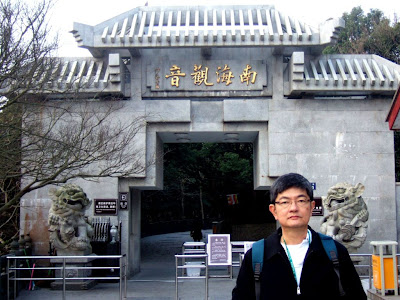
The temples are dedicated to Buddhist God of Mercy, Bodhimanda of Avalokitesvara, (Boddhisattva Guan Shi Yin). Millions of visitors landed the island on 19th of lunar month Feb, June and Sept each year to celebrate the birth of Guan Yin, date being a monk and became Boddhisattva.



Offerings of flowers, fruits, water etc were arranged in the opened altar in front of the 35 meter high South Sea Guan Yin Boddhisattva statue.


Under the breeze of south sea, Buddhist Devotees were doing their morning Sutra recitation, uniformly and loud .



Devotees circled round the huge image of Guanyin Bodhisattva and repeatedly recited his name.





A short stair way to reach the site of South Sea Guan Yin Statue.
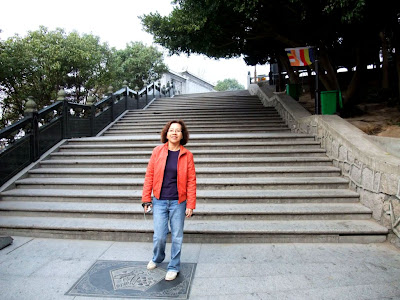

The stone wall at right side was carved with the story of Rev. Xian Zhuang's great journey to the west.


Sea views from South Sea Guanyin site.


Putoushan is one of the submerged mountain peaks rising steeply from the sea offering large area of hilly greens with wide species of plants and trees.




The scenic and quiet environment contribute a perfect setting for temples and religious buildings.


Center of Island covered with rich green forests forming a tranquil condition appropriate for a quiet religious contemplation.


The wooded bamboo forest



Enjoyed a nutritious and filling village breakfast with porridge, cruller, nuts, pickles, steamed buns and hot soy milk, outside the buildings facing a wonderful sea view. It was my first experience to watch the morning sun gradually rising from the sea with its warming beams peeping through the pine branches, while breaking the fast in the morning under a cooling sea breeze. Great!



Zi-Zhulin 紫竹林 (Purple Bamboo forest) Temple complex was named after the nearby bamboo hill.


It is very well-known for its legend of Not-leaving Boddhisattva, about the story of an Japanese monk Hui-er and his bronze Guanyin statue. It said that when Rev. Hui-er left Wutaishan sacred mountain after a pilgrimage to China in year 916 AD, he brought with him a newly acquired bronze statue of Guanyin but facing hard storming weather on the way back to Japan.



When his ship was blown up and run aground against a reef at Putoushan, Rev. Hui-er suddenly envisioned that the violent winds were a sign of Guanyin's unwillingness to leave China. He prayed and said to Boddhisattva that if Japanese countrymen were not destined to see him, he would follow the direction and build a temple for him. The storm immediately subsided and after encountered with a local man who offered his home as a shrine to house the Guanyin image, his vessel was freed from shoal and sailed peacefully back to Japan.





The spectacular architecture of Great Grand hall.



The General Funds Hall (Yuan Tong Bao Dian) was donated by Emperor Ninzong of Song Dynasty in 1214 and many buildings received great support from Royal emperors.


Original statue of Guanyin has been replaced by many replications through years but the legend remains as interesting as it was before.



The Pavilion was to mark the legend of the Japanese monk Hui-er and the not-leaving Boddhisattva image.


Zi-Zhu Lin Temple Complex nested in a midst of green with three sides surrounded by sea giving out a fascinating scenery view of the island.



Zi-Zhuling Temple complex are all painted in striking yellow.


The exquisite new shrine of "Bu Ken Qu Guan Yin Temple" 不肯去观音院 was completed in 1998.


Though the newly built temple was not big but it attracted flow of visitors as the Not-leaving Guanyin image could said to be the oldest and most important one in Putoushan's Buddhism history.



In view of his love and passion for the nation, The Guan Yin Image was highly respected and worshiped by Chinese People.



With the rhythm from ocean waves, group of Mongolian Buddhist devotees in bright red, sitting at Zi-Zhulin Temple open compound, sincerely and mindfully repeatedly recited the name of Guan Yin.
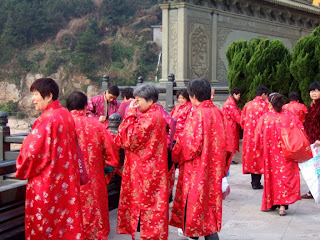






This was the place where the image of Guan Yin Boddhisattva first appeared and refused to leave. Cave of the Tidal Sound was believed to be the spot where the ship of Japanese monk sailed to after it was freed from shoal.



At Tidal Sound Cave, a rock was carved with image of Guan Yin Boddhisattva. During high tide, huge thunder sound could be heard as if voices of recitation when sea water flowing and hitting into the hole.



Temple complex was fully embraced by the beautiful seascapes.
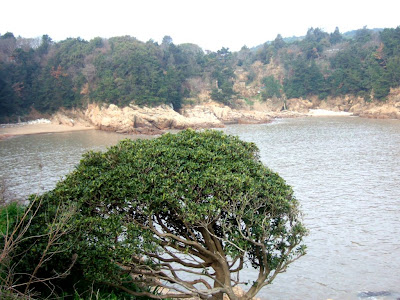

There are little bridges over Tidal Sound Cave and many twigs were starting to bloom with flowers in front of Japanese Guanyin images hall.



I was about to take a cable car up to The Buddhist Hilltop Temple, Huiji Temple which was situated at an elevated position in the island.


Marvelous scenery viewed down from Cable car.



The indicative map for scenic hill top site.


The entrance gate arch of hill top temple. On top of the main entrance fee at rmb 160.00, small contribution of about rmb5 -6 will be collected at most of the temples entrance, used to preserve the sites and its walking pathways.


The top of mountain is scenic and sacred for most pilgrims.


An old lady with blue dress was putting on his precept gown getting ready to join in other pilgrims for bowing up the hill top. She climbed and bowed through hundreds of staircase to reach Huiji Temple lying on top of the mountain.



Pilgrims practiced 3 steps one bow with hands, knees and forehead on ground after three steps to reduce one's bad karma.



The calligraphy of The Great Grand Hall 大雄宝殿 read as Da Xiong Bao Dian written on the tablet at Huiji Temple is beautiful, so is the other tablet that written with 寻声救苦 which means Follow the sound to release sufferings.


The grand hall of Huiji Temple.


While strolling down the hill, you would see stalls selling all kinds of beautiful China made Buddhist related items including shoes for the monk.


Tibetan Llama and monks were mindfully bowing up to the temple.




Thousand of staircase up to the hilltop.



Picturesque views from the peak.




Picturesque landscape along the criss-cross pathways were taken care and maintained by an army of gardeners. Putoushan is a place that protect the growth of hornbeam and old camphor tree, a fine tree species which could grow to a circumference of 6 meter. While admiring the trees on the way down from the hilltop, recitation of Guan Yin's name was heard at every corners through speaker inserted at the stone placed under trees or bushes.



Putoushan was once one of the route for international Marathon. Lady stall-owners enjoyed moment of dancing under huge Camphor trees. .


Putoushan does not offer bike rentals so most of the visitors made use of mini van network and foot. The fare of small vans which connect most of the island's attraction in minutes was around rmb3-5.00. Crowds of pilgrims heading to Fayusi for some Buddhist assembly and ceremony.ss


The bridge over the liberation pond in front of the Fayu Temple complex.



Fayu Temple which means Dharma Rain was constructed during Ming Dynasty (1368-1644. It was also known as Stone Temple. The name was changed to Fayu (Dharma Rain) after granted with a plague from Emperor Kongxi of Qing Dynasty. Written in gold on blue ground was : " Heavenly flowers Dharma Rain"
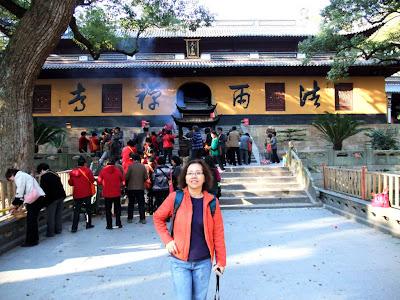

The outstanding little red hall in Fayu Temple Complex.


Fayu Temple is one of the three main temples in Putoushan, covering a land of 33,000 sq meter comprising of 294 halls and rooms with an average size of 9.300 sq. meter.


There are Heavenly Kings Hall, Jade Buddhist Hall, 9-dragons Guanyin Hall, Emperor Tablet Hall, Great Grand Hall and Abbots Hall along the trend of mountain from lower to higher.



Fayu Temple was originally named Ocean Tide constructed during Ming Dynasty by a Sichuan Monk Dazhi in 1580. It secluded by the mountain side with loft and ancients trees


The 12m wide x 9m high x 1m thick pale stone Nine Dragons wall erected in 1987 at the original site which was a three dragons wall carved on bricks with Buddhist wording "Unbelievable Power". The wall was pulled down in Cultural Revolution.


Since large scale of renovation by Emperor Yongzheng in 1731, Fayu Temple became famous in south east China.


The temple suffered wars and fire for several times, rebuilt and renovated in different period to the present scheme. The grand Hall was re-constructed in 1699 during Qing Dynasty at Kangxi 38th year.



The huge copper incense burner always is placed outside the hall to convenient the pilgrims who came here to attend Buddhist Ceremony and offered an incense of faith.


The main shrine, the offerings of flowers and its huge drum.

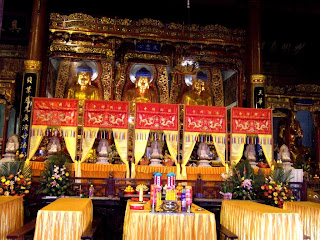

Much areas of Putoushan are covered with temples and monasteries , including a large institute of Buddhism. Whether it was in large or small scheme, all were under directive of Chinese Buddhist Association. Puji Temple Complex situated at the central part of island is a strategic location site to explore the island.


The pavilions and its delicately carved rooftops and arches at Puji Temple, mirrored in the ponds forming a beautiful and scenic spot within the complex.

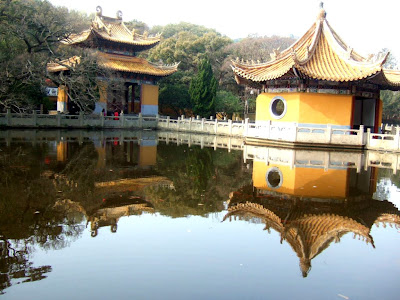


The unique Earth Store Boddhisattva Pagoda among the old building structures.


Cross over the pond is an ancient stone bridge.


A corner of old local residential quarters.


Puji Temple was the originally place of "Not Leaving Guanyin Temple" 不肯去观音院 started in Tang Dynasty (618-917). It was re-constructed, moved and name changed to Bao Tuo Guanyin Si 宝陀观音寺 in year 1080 by Emperor Shenzong in Song Dynasty who donated a piece of land for the Temple.


During the reign of Kangxi in Qing Dynasty in the year 1699 the temple started to repair and it took 32 years to complete the renovation.



The horizontal inscribed boards with wordings "Popular-saving masses of souls + saving of Buddhist Temples" were granted by Emperor Zongzheng of Qing Dynasty.


Yuantong Dian is the the main building in the complex. It housed a 8.8 meter high bronze statue of Guanyin with 32 reincarnations of the Boddhisattva on both sides. This was the only representative piece constructed by Putoushan's natives.


Puji Temple is one of the largest temple complex and most popular temple in the island.


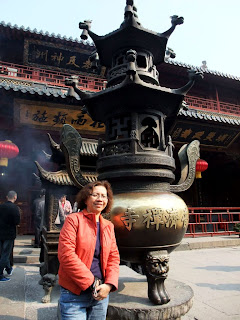
The complex consisted of 200 structures with 9 main halls, 12 pavilions and 16 houses, large in scale covering a total area of 14,000 sq meter with few 1000 years old camphor tree.



There was a legend about why side door was used instead of main door. It said that once when Emperor Zhuang, dressed in normal peasant visited the temple, a monk not allowed him to enter from main door. He thus issued an order that no one could ever go by main door since he was to go in by side door.



Besides wide area of Camphor trees, there also had camellia, peach and many other plants within the surrounding area.



Puji Temple is able to hold about 1000 people at the same time. All are welcomed to join their morning recitation session starting at 4.00 am every morning.



South West part of Putoushan covers quite a numbers of scenic spots along its 1.5km long route. It took us about 2 hours to complete the entire journey on foot.


Pan-Tuoshi is the hanging rock stacking on a few of other stones offering special effect when the evening sun shined on it.


The cow rock formation nearby when imposing sayings of your future luck, turned out to be very interesting to every body. It was believed that by touching different parts of the body except the head, one will be benefited for great lucks. Every one was putting the fingers into the hole at the back hoping to receive some lottery lucks ..................


Every body was enjoying touching the cow formation perhaps requesting for something they were looking forward to, but anyway, it was fun.


Some of the temples along the hilly way at West side scenery area. Mei Fu An was original a Taoist Temple but now a nunneries.



Breathless!



An enlightened pathway and a Dharma realm on the west.
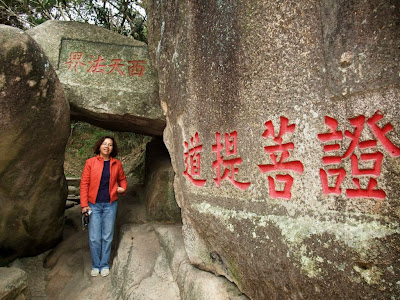

The huge rock with red heart (the wording Xin) and numerous heart shaped locks by the side. It would be a great world should every one is able to lock the heart up, preventing them to run away too far, too wild and too greed.


This area was named as Plum Curve especially beautifully at dawn 梅湾春晓. It was among the 12 most scenic spots in Putoushan.



The Temple Guanyin Gutong was actually built inside a stone cave, unique and beautiful.



Jie-Ping-An Temple (芥瓶庵) after Guanyin cave was the last temple we visited within the west side scenic area.


Rock formations appear exactly like two turtles mindfully listening to Dharma and another one looks like a wooden boat. This is the best spot offering Putoushan's delightful combination of mountain scenery and seascapes



The distance sight of the surrounding sea.



Merrily blossom wild peach flowers started to capture visitors' attention by some corners.







Along the way down hill, we encountered with plenty of these pretty little violet flowers and stalls selling local oranges which were as big as a pomelo, costing about rmb5.00 each.


Different functions of ships and boats docked at various piers within the 400 small islands.



The speed ferries at Zhoushan City on Zhoushan Island connected all bus passengers to and from Putoushan charged at a fare of rmb 24.00 for a ride of about 30 minutes.



The popular Jia-Xing Rice dumplings sold at the stop-by rest area within Shanghai and Putoushan highway, came in various types with plenty of different stuffing at a price of about rmb 5.00 each, and they really tasted good especially the one with the red-bean paste.



No comments:
Post a Comment